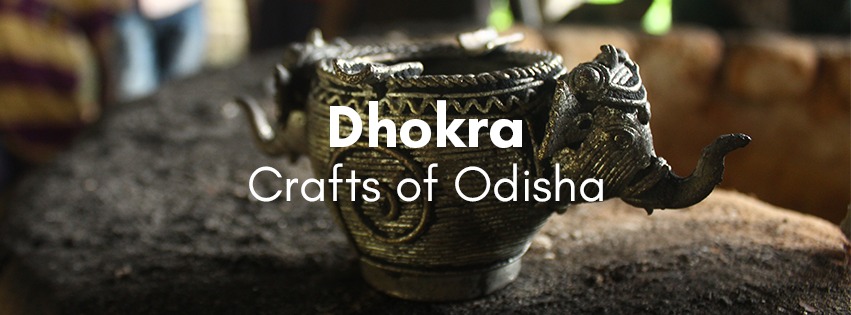India, as we see it today, is a product of generational evolution made up mostly of people and stories. History and culture runs through the veins of this beautiful subcontinent. One such integral aspect of India’s history can be found in the tiny intricacies of ancient crafts. If you visit any rural area in India, you will almost always notice how they are extremely self-reliant – capable of creating almost every item they need.
A bunch of such mystical creators live in the eastern coast of India, in the state of Odisha, which is home to India’s oldest (presumably) handicraft that dates back its origin to the Indus Valley civilisation. Don’t believe us? Take a trip yourself to the famous Sadeipbareni village in Dhenkanal district where villagers still melt magic into moulds to create Dhokra craft, the age-old art of metal casting using the lost-wax technique. This captivating craft, practiced for millennia, continues to enthrall with its intricate designs and enduring legacy.
Dhokra, Lost Wax History In Odisha
Lost wax process was practiced in India since the Bronze Age (3000-1800BC). The beautiful dancing girl found in Mohenjodaro is testament to our rich history. The name itself is derived from the West Bengal’s Dhokra Damar adivasi community, who have been traditionally associated with this art form. The essence of Dhokra lies in the ingenious lost-wax technique.
A research paper titled TRADITIONAL KNOWLEDGE ON DHOKRA CRAFT OF MAYURBHANJ by Champak Kumar Sahu (Dept of Anthropology and Tribal studies.North Orissa University, Sriramchandra vihar, Baripada, India) says, “At the time of feudal state the king Purna Chandra Bhanja Deo had called the Thatari, that were already familiar with the cost wage problem and cast tools, weapons, ornaments etc.. This family moved from the village Kuruma near Karanjia subdivision of Mayurbhanj district which is 120km away from the present village (Fig. 1). The family was preparing utensils for the royal family. According to the district gazette “thatari caste are a class of brazier and brass workers. Their number is rather few in the district.” (N. Senapati 1967: 115). Mayurbhanj is home to several cultural rich societies. Rana (the bania) family are in close association with metal craft and manufacturing attractive range of decorative objects using a variety of metal like kanga (brass), Pittal, aluminum etc. The technology of metal like high-tin, bronze, kansa (brass) and Pittal melting and tool making was responsible for bringing a great revolution in human life. Earlier this family was also preparing “eight metal amalgam” (Astodhatu) deities and jewelry for the king. The astodhatu (Eight Metal) consisted of Gold (suna) Silver (rupa) Copper (tomba) Iron (luha) Zinc (dosta) Tin (tino) Lead (sisa) and Mercury (paroda).”
Dhokra: Present Day In Odisha
The traditional knowledge of Dhokra casting is limited only to a certain pockets in Odisha – Kuliana in Mayurbhanj, Ghigidi in Raygoda, Koramula in Dhenkanal, and Kalmat in Keonjhar district.


Dhokra Tools & Materials
Dhokra casting includes several equipment found in nature, coupled with some hand made tools. The basic materials include: resin, salt, clay, sand, paddy chaff and wood. They can all be found in the vicinity of the craftsmen.
r. Sahu’s extensive research brought together several aspects of the craft. It’s incredibly mesmerizing the amount of things craftsmen procure from nature to design a perfect dhokra craft. Beeswax-(Maham), a raw material is foraged by the tribal communities from whom craftsmen buy. Resin (jhuna), grinding slab (the clay paste is groung with this stone) and hand stone (silo putta) iron blade, (Arisi patia) the wax press (Janta), clay (mati), lado ( fired clay) the fired shards of the clay forms are finely ground and mixed with the fresh clay to make it stronger against high temperature. Cow dung (gobor), sickle (daa), hammer (Hatudi), Chisel (Chhini), weight machine (dandi), brass (pittal) when the brass objects like bowls, water vessels, measuring bowls worn out such items are sold to scrap metal dealer at half rate. These various metals are what your final dhokr craft is made from!
Let’s take a look at the Dhokra process briefly.
-
Molding Magic:
Dhokra artisans begin by meticulously crafting clay molds. These molds often depict figurines of deities, animals, and everyday objects, each imbued with a sense of narrative. Wax, often mixed with tar, is often used to create threads that are used to create intricate designs on the clay surface. This wax is later replaced with metal, and the design comes alive!
-
The Art of the Cast:
Once the wax design is complete, another layer of clay is applied, creating a sealed mold. After having sun dried, the mold is heated, causing the wax to melt and escape, leaving behind a hollow cavity mirroring the wax design.
-
Molten Metal Majesty:
Molten metal, traditionally bronze or brass, is then poured into the preheated clay mold. After cooling, the mold is broken away to reveal the exquisite metal casting, capturing the essence of the original wax design. They often also mix other metals easily available.
-
Finishing Touches:
The final step involves meticulous filing, polishing, and burnishing to bring out the radiant sheen and intricate details of the Dhokra piece.
The beauty of Dhokra lies not just in the finished product but in the very process itself. It’s a testament to the ingenuity and skill of the artisans, who have passed down this knowledge through generations, ensuring the survival of this ancient art form.
Enchanting Odisha Dhokra
While Dhokra is practiced across various parts of India including West Bengal, Chhattisgarh, and parts of Jharkhand, Odisha stands out as a hidden gem for this craft. Here, the art flourishes in several tribal communities, each with its own unique style and motifs.
- Dhenkanal & Keonjhar: Dhenkanal & Keonjhar districts in Odisha are renowned for its Dhokra, characterized by bold geometric patterns and figurines depicting everyday life and tribal deities. The bell metal used here adds a distinct charm to the pieces. The most popular village here is Sadeibareni, with several small pockets spread around where the craft is still practised.
- Rayagada: Rayagada, another haven for Dhokra, is known for its delicate and intricate work. Artisans here excel in crafting jewelry, figurines, and household items adorned with floral and animal motifs. The black dhokra craft made by the Dongria Kondh tribe here is in quite a demand worldwide.
- Mayurbhanj: Mayurbhanj district boasts a vibrant Dhokra tradition. The horse and elephant figurines crafted here are particularly sought-after, known for their lifelike features and intricate detailing.
Odisha’s Dhokra offers a unique perspective on this ancient art form. The use of locally-sourced materials, the influence of tribal art styles, and the emphasis on functionality set Odisha Dhokra apart. These handcrafted pieces are not just decorative objects but embody the cultural heritage and artistic expressions of Odisha’s tribal communities. Every piece you hold in your hand is not just a craft, but generations of knowledge passed down – a gateway into India’s earliest livelihood.
The Socio-Economic Significance of Dhokra
Dhokra is more than just a captivating art form; it’s a source of livelihood for thousands of artisans in Odisha, particularly in tribal communities. The intricate process involves skilled craftsmanship, passed down through generations. By supporting Dhokra, we empower these communities and ensure the preservation of this age-old tradition.
In recent years, Dhokra has gained wider recognition, finding its way into homes and art collections worldwide. This growing appreciation has led to a positive impact on the lives of Dhokra artisans, providing them with a sustainable source of income and a platform to showcase their exceptional skills.
Contemporary Dhokra
With time, the artisans have adapted to the contemporary developments in art forms. They now create all kinds of new designs that match the taste of modern civilizations- ranging from keychains, stylistic decorative, jewelry, storages, etc.
If you’re captivated by the allure of Dhokra, here are some ways to experience this art form firsthand:
- Visit Odisha: Immerse yourself in the cultural heartland of Odisha Dhokra. Visit artisan villages, witness the Dhokra-making process firsthand, and interact with the artisans themselves. Several government initiatives and NGOs organize workshops and tours to promote Dhokra tourism. Not just that, when you visit them you can buy directly from these local artisans which will help keep this craft alive. Besides, they will earn directly.
- Explore Online Marketplaces: Numerous online platforms showcase and sell authentic Dhokra pieces directly from artisans. You can explore a plethora of contemporary and traditional dhokra craft pieces across various e-commerce sites who procure from age-old artisans.
While this craft still remains alive in some pockets, the onus falls on us to preserve it further. It cannot persist without our support and new design thinking applied to the material. The possibilities of exploring the Dhokra craft in new contemporary format is limitless, at BEADS we are constantly experimenting with the craft.










1 thought on “All You Need To Know About Stunning Dhokra Craft, Odisha”
Very interesting information!